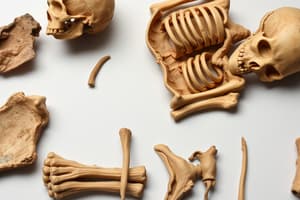Podcast
Questions and Answers
What is an archaeologist?
What is an archaeologist?
A scientist who learns about ancient people by studying the things they left behind.
What is forensic anthropology?
What is forensic anthropology?
A specialist who examines skeletons for clues that will provide evidence about the life and death of the people to whom they belonged.
How did the team know the fort wall was already up when the grave was dug?
How did the team know the fort wall was already up when the grave was dug?
The grave was outside and parallel to the fort wall.
What does 'excavate' mean?
What does 'excavate' mean?
Who are historians?
Who are historians?
What did a coffin during colonial times suggest about the person inside?
What did a coffin during colonial times suggest about the person inside?
What was the artifact found in the grave called?
What was the artifact found in the grave called?
What did the leading staff mean for the person who owned it?
What did the leading staff mean for the person who owned it?
What happened when the water drained from the sand?
What happened when the water drained from the sand?
Why did they think the captain's bones were shrouded?
Why did they think the captain's bones were shrouded?
What does 'corrode' mean?
What does 'corrode' mean?
How did they determine his age?
How did they determine his age?
Flashcards are hidden until you start studying
Study Notes
Archaeology and Forensic Anthropology
- Archaeologist: A scientist who studies ancient civilizations through artifacts and remains.
- Forensic Anthropology: Specialists in analyzing skeletons to uncover details about individuals' lives and deaths.
Historical Context and Evidence
- The fort wall's presence indicated the grave was dug afterward, as it was located outside and parallel to the fort.
- Coffins from colonial times signified the individual’s importance, suggesting they held a notable status.
Artifacts and Their Significance
- An iron pike, interpreted as a leading staff, was discovered in the grave, symbolizing honor and respect for the deceased.
Excavation Process
- Excavation involves digging and removing earth to uncover historical artifacts and remains.
- When the water drained from the sand, the soil’s moisture level altered, impacting the excavation conditions.
Analysis of Remains
- The positioning of the captain's knees and legs suggested he had been shrouded, likely due to the burial customs of the time.
- Signs of corrosion were observed on artifacts, indicating deterioration over time.
- Age assessment of the captain was conducted through analysis of his fused epiphyses, spine, and arm lipping, which are indicators of maturation.
Studying That Suits You
Use AI to generate personalized quizzes and flashcards to suit your learning preferences.



